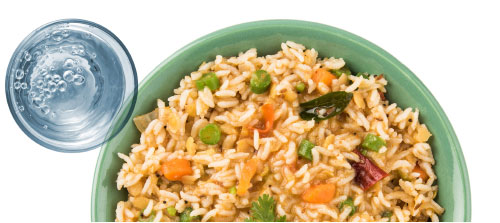
சென்னையில் சாஃப்ட்வேர் நிறுவனத்தில் வேலை பார்க்கும் இளம் பெண் நிஷா. ஹெல்த் விஷயத்தில் மிகவும் அக்கறை கொண்டவர். ஃப்ரெஷ் ஜூஸ், பழ- காய்கறி சாலட், முளைவிட்ட தானியங்கள் இவைதான் அவர் உணவில் பிரதானமாக இருக்கும். என்னதான் ஆரோக்கியத்தின் மீது கவனம் செலுத்தினாலும், அடிக்கடி அவருக்குத் தலைவலி வந்தது. நாளடைவில், வாந்தி, மனக்குழப்பம், அவ்வப்போது மயங்கிவிழுவது, மயங்கியநிலையில் உளறுவது போன்ற பிரச்னைகள் இருந்தன. டாக்டரைப் பார்த்து மருந்துகள் பல எடுத்தும், பிரச்னை சரியாகவில்லை. திடீரென ஒருநாள் அலுவலகத்தில் வலிப்பு வந்து மயங்கினார். உடனடியாக அவரை அருகில் உள்ள சூப்பர் ஸ்பெஷாலிட்டி மருத்துவமனைக்குக் கொண்டு சென்றனர். அங்கு, அவருக்கு ஸ்கேன் செய்யப்பட்டது. மூளை மற்றும் சில முக்கிய உறுப்புகளில் புழுக்கள் நெளிவது கண்டறியப்பட்டது. உடனடியாக அவருக்கு சிகிச்சை அளித்துக் காப்பாற்றினர்.
பின்னர், எதனால் அவருக்கு இதுபோன்ற புழுக்கள் வந்தன எனக் கண்டறிய, அவரிடம் டாக்டர் பேசினார். அவருடைய பழக்க வழக்கங்கள் அனைத்துமே ஹெல்த்தியாகவும், ஹைஜீனிக்காகவும் இருந்தன. உணவு பற்றி சொல்லும்போதுதான் சந்தேகம் வந்தது. நிறையப் பச்சைக் காய்கறிகள் சாப்பிடுவது நல்லது என்பதற்காக, சரியாகச் சுத்தம் செய்யாமல் சாப்பிட்டது தான் பிரச்னைக்குக் காரணம் என்று டாக்டர்கள் கண்டறிந்தனர். டாக்டர்கள் இதைச் சொல்லம்போது நிஷா அதிர்ச்சியில் உறைந்துபோனார்.

ஹெல்த்தி என்ற வார்த்தை இன்று அனைவரின் ஒரே விருப்பமாகிவிட்டது. ஹோட்டல்களில்கூட ஹெல்த்தி கிச்சன் என்ற தங்கள் பிராண்டைப் பிரபலப்படுத்துகின்றனர். எது உண்மையான ஆரோக்கியம்? காய்கறிகளில் உள்ள ஊட்டச்சத்துக்கள் அழிந்துவிடக் கூடாது என்று செய்யப்படும் சாலட், சாண்ட்விச், ஃப்ரெஷ் ஜூஸ், பாதி வேகவைக்கப்பட்ட உணவுகள் என எத்தனையோ உணவு வகைகள் `ஆரோக்கியமானது’ என்ற பெயரில் பரிமாறப்படுகின்றன. உண்மையில், இந்த உணவுகள் ஊட்டச்சத்து நிறைந்தவைதான் என்றாலும், சுகாதாரமானவையா என்ற கேள்வி முக்கியமானது. ஆரோக்கியத்துக்குத் தேடித்தேடிச் சாப்பிடலாம், அது ஹைஜீன்தானா என்பதை எப்படித் தெரிந்துகொள்வது என்ற சந்தேகம் எழலாம்.
டேனியா சோலியம் (Taenia solium) என்ற நாடாப் புழு. இதை, `போர்க் டேப்வார்ம்’ (Pork tapeworm) என்று சொல்வர். இது, மனிதனின் குடலில் இருக்கும். மலம் வழியாக இதன் முட்டைகள் வெளிவரும், இந்தப் புழுக்களின் முட்டைகள் உள்ள உணவை உட்கொள்ளும்போது, வயிற்றில் இந்தப் புழுக்கள் வளர ஆரம்பிக்கும். இரண்டு மூன்று மீட்டர் அளவுக்குக்கூட ரிப்பன்போல வளரும். இதன் தலையின் பெயர் கொலெக்ஸ். அதாவது, தலை ‘சக்கர்’ மாதிரி தசையில் இறுக்கமாகப் பிடித்துக்கொண்டு அப்படியே மிதந்துகொண்டே இருக்கும். இதன் ஆண்-பெண் என்ற இருபாலினமும் ஒரே உருவில் இருக்கக்கூடியவை.
இதன் முட்டைகள் மனித மலத்தின் வழியாக வெளியேறுவதால், மண், தரை, செடி, கொடி எனப் பரவ வாய்ப்புகள் உள்ளன. நீர்நிலைகளில் கலப்பது, வயல்வெளிகளில் பரவுவது மட்டும் அல்ல... செருப்பு இல்லாமல் நடக்கும்போது கால்களில் ஒட்டிக்கொள்ளும். இந்தப் புழுக்களின் முட்டை முதலில் பன்றி உள்ளிட்ட கால்நடைகளின் உடலில் சென்று வளர ஆரம்பிக்கும். பன்றியின் ரத்தத்துக்குச் சென்றுவிட்டால், அது உடலில் எங்கு வேண்டுமானாலும் செல்ல முடியும். லார்வா நிலையில் பல ஆண்டுகள்கூட பன்றியின் உடலில் இவை வாழும். இந்தத் தொற்று நிறைந்த இறைச்சியை சாப்பிடுவதால் நமக்கும் பாதிப்பு ஏற்படுகிறது.

என்ன பிரச்னைகள் வரும்?
சரியாக வேகவைக்கப்படாத தொற்று இறைச்சியைச் சாப்பிடும்போது, இவை மனிதனின் வயிற்றுக்குள் சென்று, முட்டையிட்டு வளரும். குறிப்பாக, சமைத்துக்கொண்டிருக்கும்போதே வெந்துவிட்டதா எனச் சுவைத்துப் பார்க்கும்போது, இந்த லார்வா வயிற்றுக்குள் சென்றுவிட வாய்ப்பு அதிகம். எனவேதான், `இறைச்சியை நன்கு வேகவைத்து உட்கொள்ள வேண்டும்’ எனப் பரிந்துரைக்கிறார்கள்.
கால்நடை மூலமாக மட்டும் அல்ல, நேரடியாகவும் இந்த முட்டைகள் நம் வயிற்றுக்குள் செல்ல வாய்ப்பு உள்ளது. இதை, சிஸ்டிசர்கோசிஸ் (Cysticercosis) என்று சொல்வர். அதாவது, பன்றியின் உடலில் என்ன நடக்கிறதோ, அதேபோல் நம் குடலிலும் அவை வளரத் தொடங்கும். இது, எந்த உறுப்புக்கு வேண்டுமானாலும் நகர்ந்து செல்ல முடியும். சிறுநீரகம், கல்லீரல், குடல், சில சமயம் சுவாசப் பகுதி, உணவுக்குழாய்க்குகூடச் செல்லலாம். இதுவே, முதுகுத்தண்டு, மூளை எனப் பரவினால், நரம்பு தொடர்பான பிரச்னைகள் வரும். மூளைக்கு இந்த புழுக்கள் சென்றால், நியூரோ சிஸ்டிசர்கோசிஸ் எனும் வலிப்பு நோய் வரும். பெரும்பாலானோருக்கு, ஏதாவது ஒரு காரணத்தோடு வலிப்புநோய் வருமானால், அவருக்கு இந்த மாதிரியான புழுக்கள் அல்லது அதன் முட்டைகள் மூளையில் பரவியிருக்கக்கூடும்.
யாருக்காவது வலிப்புப் பிரச்னை இருந்தால், ஸ்கேன் செய்வதற்கான முதல் காரணம் இந்த மாதிரியான புழுக்கள் அதன் முட்டைகள் இருக்கின்றனவா என்று தெரிந்துகொள்வதற்காகதான்.
இது மூளை, மூளையைச் சுற்றிய பகுதி, முதுகுத் தண்டுவடம், கண்கள் என எங்கு வேண்டுமானாலும் இருக்கலாம். இவை, எந்த இடத்தில் இருக்கின்றன என்பதைப் பொறுத்து, பிரச்னைகள் வெவ்வேறுவிதமாக ஏற்படும். கண்களில் இருந்தால், பார்வைக் கோளாறுகள் வரும். மூளையின் சில முக்கியப் பகுதிகளில் இருந்தால், பக்கவாதமும் ஏற்படலாம். தலைவலி, மூளை வீக்கம், மூளைத் தொற்று, தொடர் வாந்தி, சோர்வு, எரிச்சல், குழப்பமான மனநிலை போன்ற பிரச்னைகளும் வரலாம். இதில், பொதுவான அறிகுறி வலிப்புப் பிரச்னை. அவரவர் உடல்நிலையைப் பொறுத்து, அறிகுறிகள் மாறுபடும்.

முதுகுத்தண்டுவடத்தில் இருந்தால், இரண்டு கால்களும் வராமல் பக்கவாதம் வரலாம். நடக்கக் கஷ்டப்படலாம். மூளையிலும் முதுகுத்தண்டுவடத்திலும் இந்தப் புழுக்கள் சென்றுவிட்டால், பிரச்னைகள் தீவிரமாகும்.
சருமத்தின் கீழே முடிச்சு முடிச்சாக, உருண்டை உருண்டையாக இவை இருக்கலாம். சிலருக்குச் சதைவலி, வீக்கம் இருக்கும். அவர்களை ஸ்கேன் எடுத்துப்பார்த்தால், இந்தப் புழுக்கள் தசைகளில் ஒட்டியிருக்கக்கூடும்.
மலத்தின் மூலமாக இவை பரவுவதால், தண்ணீரின் மூலமாகக் காய்கறிகள், பழங்கள் போன்றவற்றிலும் பரவ முடியும். இந்தப் பிரச்னை அசைவம், சைவம் சாப்பிடுவோர் என யாருக்கும் வரலாம்.
தனிப்பட்ட சுகாதாரம் என்பது மிகவும் முக்கியம். மலம் கழித்துவிட்டு கைகளைச் சரியாக கழுவாமல் இருந்தாலும் பிரச்னைதான். சுகாதாரமற்ற நீரால் சமைக்கப்படும், கழுவப்படும் உணவுகள் மூலமாகவும் பிரச்னை ஏற்படும். இதற்கு பெயர் ஆட்டோ இன்ஃபெக்ஷன்.

என்ன தீர்வு?
பெரும்பாலும் அறுவைசிகிச்சை இன்றி, மருந்து மாத்திரைகள் மூலமே சரிசெய்ய முடியும். பிரச்னையைக் கவனிக்காமல்விட்டால், தீவிரமாகும். மருத்துவர் ஆலோசனையின்படி குழந்தைகளுக்குக் கொடுக்கும் அல்பென்டாசோல் (Albendazole) எனும் மருந்தை, காலை, மாலை என இரண்டு மூன்று வாரங்களுக்குச் சாப்பிடுகையில், இந்தப் பிரச்னை சரியாகிவிடும்.
வயிற்றினுள் மட்டும் பூச்சி இருப்பவர்களுக்கு வேறு மருந்து அளிக்கப்படும். இப்படி, ஒவ்வொருவரின் பிரச்னையைப் பொறுத்து, மருந்துகள் பரிந்துரைக்கப்படும். இந்த மருந்துகளை உட்கொண்ட பின்னரும், தனக்கென பெர்சனல் ஹைஜீனை உருவாக்கிக்கொள்ளவில்லை என்றால், நிச்சயம் மீண்டும் புழுக்கள், முட்டைகள் உடலில் பரவத் தொடங்கிவிடும். மருத்துவர் ஆலோசனைப்படி அனைவரும் பொதுவாக மூன்று மாதங்களுக்கு ஒருமுறை வயிற்றைச் சுத்தப்படுத்தும் மருந்துகளை உட்கொள்வது பாதுகாப்பைத் தரும்.
- ப்ரீத்தி, படம்: எம்.உசேன், மாடல்: லுய்னா
தொடர்ந்து சாலையோர உணவை உட்கொள்பவர்களுக்கு, பெரும்பாலும் இதன், முட்டைகள் உடலில் கலந்து பிரச்னைகளை ஏற்படுத்தும். எந்த வகையிலும் முட்டைகள் உடலில் செல்ல வாய்ப்புகள் அதிகம் என்பதால், தனக்கென்ற ஒரு சுகாதார முயற்சியும், கட்டுப்பாடும் இருந்தால் மட்டுமே இந்தப் பிரச்னைகள் வராமல் தவிர்க்க முடியும்.
ஹோட்டல், வீடு, அலுவலகம் என எங்கு பார்த்தாலும் சாண்ட்விச், சாலட் மோகம் அதிகரித்துள்ளன. `உடலுக்கு நல்லது, உடல் எடையைக் குறைக்கும், ஆரோக்கிய நொறுக்குத்தீனி’ எனப் பல நன்மைகள் அடங்கியிருந்தாலும் அவை எந்த அளவுக்கு சுகாதாரமானவை என்பதைப் பொறுத்தே ஆரோக்கியம் முழுமைபெறும்.

கடைகளில் சாண்ட்விச் வாங்கிச் சாப்பிடுவதைத் தவிர்த்து, வீட்டிலேயே செய்து சாப்பிடலாம். வீட்டில் சாலட், சாண்ட்விச் தயாரிக்கும் முன்னர், தேவையான காய்கறி, பழங்களை உப்பு கலந்த நீரில் 20 நிமிடங்கள் ஊறவைக்க வேண்டும். பின்னர், மஞ்சள் கலந்த நீர், புளி கலந்த நீர் ஆகியவற்றில் கழுவிவிட வேண்டும். பாத்திரத்தில் வெந்நீரை வைத்துக்கொண்டு, அதில் நறுக்கிய காய்கறிகளைப் போட்டு எடுத்த பின் சாலட் தயாரிக்கலாம்.
சூப், குழம்பு, கிரேவி ஆகிய கொதிக்க வைக்கப்பட்ட உணவுகளில்கூட முட்டைகள் சாகாமல் இருக்கலாம் என்பதால், பன்றி, மாடு, ஆடு போன்ற இறைச்சியை ஒரு முறை தனியாக வேகவைத்த பின்னர், மீண்டும் சமையலில் சேர்த்து வேகவைக்க வேண்டும்.
தடுக்கும் வழிகள்!
சுகாதாரமற்ற இடங்களில் உட்கொள்வதைத் தவிர்க்க வேண்டும்.
ஜூஸ், சட்னி போன்ற கொதிக்கவைக்கப்படாத, தண்ணீர் சேர்க்கப்படும் உணவுகளை உட்கொள்வதற்கு முன்னர், அந்தப் பகுதியின் சுகாதாரநிலையைச் சரிபார்த்துக்கொள்வது முக்கியம்.
காய்கறிகளை வெட்டும்போதும், உணவு பரிமாறும்போதும் கைகளை நன்கு சுத்தம் செய்துகொள்ள வேண்டும்.
சாப்பிடுவதற்கு முன்பும் பிறகும் நன்றாக சோப் போட்டு கை கழுவ வேண்டும்.
மலம் கழித்த பிறகு கைகளை நன்கு சோப் அல்லது கிருமிநாசினி போட்டு சுத்தம் செய்ய வேண்டும்.
பொது இடங்களில் கழிப்பறை பயன்படுத்துகையில் குழாய், டவல், கைப்பிடி, பேசின் போன்றவற்றைக் கையாள்வதில் கவனம் தேவை. தொட்டுவிட்டாலும் கைகளைச் சுத்தப்படுத்திக்கொள்ள வேண்டும்.
இறைச்சியை நன்றாக வேகவைக்க வேண்டும். மஞ்சள் தூளை உணவில் சேர்ப்பது முக்கியம்.
சாலட் சாப்பிடுபவர்கள், காய்கறிகளை நன்றாகக் கழுவினாலும், மூன்று நிமிடங்களுக்கு வெந்நீரில் போட்டு எடுப்பது அவசியம்.
கடைகளில் விற்கும் பழங்கள், காய்கறிகளை, கழுவாமல் சாப்பிடுவது தவறு.
சாட் உணவு உட்பட பலவற்றில் கொத்தமல்லி இலையைச் சுவைக்காகச் சேர்ப்பார்கள். இதன் வழியாகப் புழுத்தொற்று ஏற்பட வாய்ப்பு உள்ளது. எனவே, புதினா, கொத்தமல்லி, கறிவேப்பிலையை வெந்நீரில் சில நிமிடங்கள் நனைத்துப் பயன்படுத்தலாம்.
புழுக்கள் பலவிதம்
கொக்கிப்புழுவும் (Hookworm) பரவக்கூடியதே. சுகாதாரமற்ற இடங்களில் நடக்கும்போது, கொக்கிப்புழுக்களின் முட்டைகள் காலில் ஒட்டிக்கொள்ளும். சருமத்தின் வழியாக ரத்தத்தில் கலந்து, குடலுக்குச் சென்றடைந்து வளரும். அங்கு, இனப்பெருக்கத்தில் ஈடுபடும். ஒரு நாளைக்கு ஒரு பெண் கொக்கிப்புழு கிட்டத்தட்ட 35 ஆயிரம் முட்டைகள் வரை இடும். இவை, சிறுகுடலில் கொக்கிபோல ஒட்டிக்கொண்டு, ஊட்டச்சத்துக்களை உறிஞ்சிக்கொண்டிருக்கும். இதனால், ரத்தசோகை உள்ளிட்ட பிரச்னைகள் ஏற்படும். எனவே, வயல்வெளி, மைதானம் போன்ற இடங்களில் வெறும் காலில் நடப்பதைத் தவிர்க்க வேண்டும்.

ஊசிப்புழு (Pinworm) என்ற சின்னச்சின்னப் புழுக்கள் மலத்தில் காணப்படும். இவை, பெரும்பாலும் குழந்தைகள் இருக்கும் வீட்டில் பரவியிருக்கும். காற்றின் மூலமாகவும், தொடுதலின் மூலமாகவும் மற்றவர்களுக்குப் பரவ வாய்ப்பு உள்ள புழு இது. குழந்தைகளின் வயிற்றில் இந்தப் புழுக்கள் இருந்தால், அந்த வீட்டுப் பெரியவர்களுக்கும் இவை பரவும். குடும்பத்தில் அனைவரும் மருந்துகளை உட்கொண்டால் மட்டுமே, இவற்றைக் கட்டுப்படுத்த முடியும்.
ஆஸ்காரிஸ் (Ascaris) புழு, உணவுகளிலிருந்து நம் உடலுக்கு வருகின்றன. சுகாதாரமற்ற நீர் மற்றும் உணவுகளின் மூலம் பரவும் இந்தப் புழுக்கள் வயிற்றுப்போக்கு, வாந்தி போன்றவற்றை ஏற்படுத்தும்.





 Ahmed Patel Verified account @ahmedpatel
Ahmed Patel Verified account @ahmedpatel 
